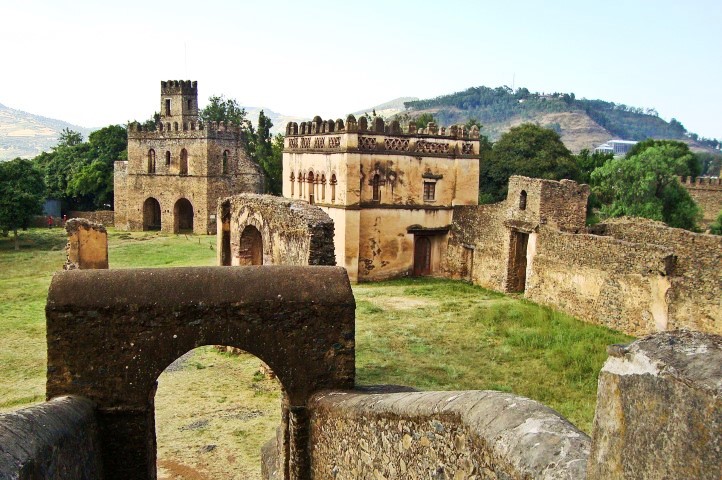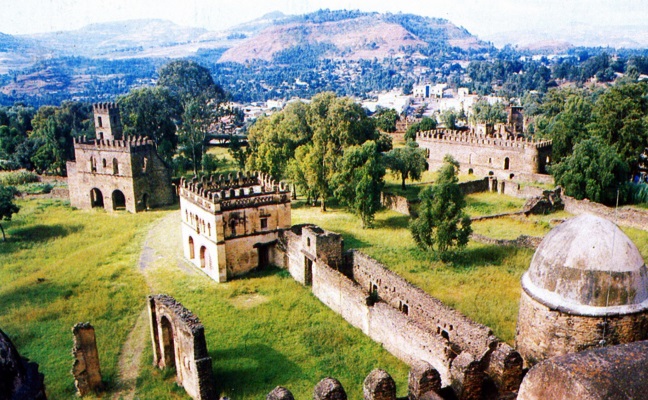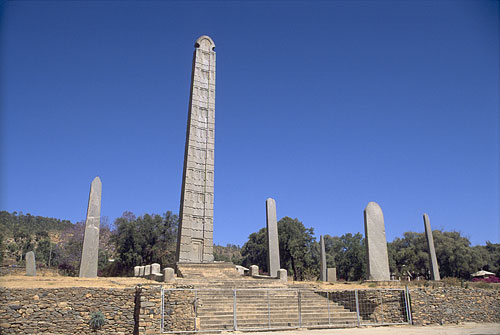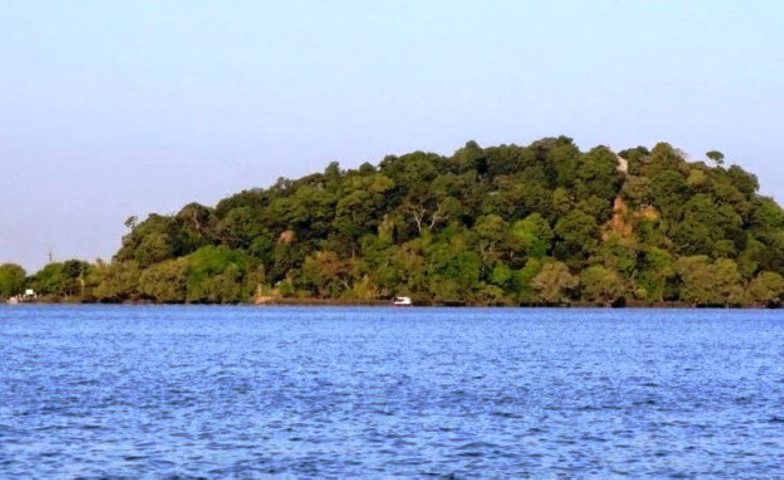North Historic
The Historic North and the Simien Mountains
An ancient land of fertile well-watered mountains that form the main source of the Blue Nile, northern Ethiopia has long stood at the cultural crossroads of Africa, Arabia and the Mediterranean. These divergent influences have bequeathed the region a unique cultural and historical heritage epitomized by a quartet of unique and magnificent UNESCO World Heritage Sites - Aksum, Lalibela, Gondar and the Simien Mountains National Park - as well as a vast array of lesser-known but equally fascinating historical sites.
• Three thousand year old Aksum, a UNESCO World Heritage Site where obelisks as tall as ten-storey buildings overlook mysterious ruined palaces once inhabited by the Queen of Sheba and a temple that is said to house the Biblical Ark of the Covenant.
• Also a UNESCO World Heritage Site, the atmospheric 12th-century complex of rock-hewn churches at Lalibela, still active shrines of worship today, has been dubbed the “Eighth Wonder of the World”.
• Freshwater Lake Tana, a vast inland sea fringed by tropical greenery, is dotted with evocatively painted island monasteries such as Ura Kidane Mihret and Narga Selassie
• The Camelot of Africa, Gondar is best known for the magnificent 17th century castles that adorn its Fasil Ghebbi UNESCO World Heritage Site.
• The spectacular hiking trails that traverse Simien Mountains National Park, a UNESCO Natural World Heritage Site, provide an opportunity to see Walia ibex and other endemic wildlife, or to ascend the country's highest peak, the 4,533m Ras Dejen.
• Negash is Ethiopia’s oldest Islamic settlement, established by a group of Muslim refugees that included close relatives of the Prophet Mohammed during his lifetime.
• The Blue Nile, which arcs southwest from its source in Lake Tana, plummets over a spectacular 45m high waterfall called Tis Isat (Water that Smokes) into a mile-deep gorge whose scale invites comparisons to the Grand Canyon.
The towering sandstone outcrops of the Gheralta Escarpment are incised with around two-dozen isolated rock-hewn churches reached along challenging but wonderfully scenic footpaths.

Gondar is a Royal and ancient historical city of Ethiopia. It is the home of many Emperors and Princess who lead the country from the 12th century to the last decade of the 20th century. To mention just a few, Emperor Suseneos, Emperor Fasiledes, Empress Mentwab, Iyasu I, Tewodros II, Empress Taitu. It is the home of the highest mountain in Ethiopia, Ras Dashen, and the Simien Mountains National Park.
Gondar Attractions
Debre Berhan Selassie
Debre Berhan Selassie is beautiful churches. Appealing as it is on the outside with its stone walls, arched doors and two-tiered thatch roof, it's the inner sanctuary of Debre Berhan Selassie, with its glorious frescos, that really shines. But it was very nearly destroyed like most of Gonder’s other churches. When the marauding Sudanese dervishes showed up outside the church gates in the 1880s, a giant swarm of bees surged out of the compound, chasing the invaders away.
The ceiling, with its rows and rows of winged cherubs representing the omnipresence of God, draws most eyes. There’s space for 135 cherubs, though 13 have been erased by water damage. Aside from the cherubs the highlights have to be the devilish Bosch-like depiction of hell. Although local tradition attributes most paintings to the 17th-century artist Haile Meskel, this is unlikely because the building only dates back to the late 18th century. The original circular church, created in the 1690s by Iyasu I, was destroyed by lightning.
A large stone wall with 12 rounded towers surrounds the compound and these represent the 12 apostles. The larger 13th tower (entrance gate) symbolises Christ and is shaped to resemble the Lion of Judah. If you have a keen eye, you’ll be able to spot the lion’s tail above the doorway in the wall west of the church.
Flash photography inside the church is forbidden. Priests offer tours, but a small contribution for the church should be left afterwards.

By far the most impressive, and also the oldest, building is Fasiladas’ Palace, just inside the entrance gate. It stands 32m tall and has a crenulated parapet and four domed towers. Made of roughly hewn stones, it’s reputedly the work of an Indian architect and shows an unusual synthesis of Indian, Portuguese, Moorish and Aksumite influences. The main floor was used as dining halls and a formal reception area. Note the wall reliefs, including several Stars of David, which trumpet Fasiladas’ link to the Solomonic dynasty. The small room in the northern corner boasts its original beam ceiling and some faint frescoes. On the 1st floor, Fasiladas’ prayer room has windows in four directions, each overlooking Gonder’s important churches. Religious ceremonies were held on the roof, and it was from here that he addressed his people. Above Fasiladas’ 2nd-floor bedroom was the watchtower, from where it’s (apparently) possible to see all the way to Lake Tana. Behind the castle are various ruined buildings, including the kitchen (domed ceiling), steam bath and water cistern.
Palace of Iyasu I
To the palace’s northeast is the saddle-shaped Palace of Iyasu I, with its unusual vaulted ceiling. The son of Yohannes I, Iyasu I (r 1682–1706) is considered the greatest ruler of the Gonderine period. The palace used to be sumptuously decorated with gilded Venetian mirrors and chairs, with gold leaf, ivory and beautiful paintings adorning the walls. Visiting travellers described the palace as ‘more beautiful than Solomon’s house’. Although a 1704 earthquake and British bombing in the 1940s have done away with the interior and most of the roof, its skeletal shell reeks of history.
Other Southern Buildings
North of Iyasu’s palace is the relics of its banquet hall and storage facilities. To the west is the quadrangular library of Fasiladas’ son, Yohannes I (r 1667–82), which was plastered over by the Italians in a nonhistoric renovation. (In fact, all plaster found in the Royal Enclosure compound was added by the Italians.) Once an impressive palace decorated with ivory, only the tower and walls of Fasiladas’ Archive remain. It sits northwest of the library.
Northern Buildings
The compound’s northern half holds vestiges of Dawit’s Hall, known as the House of Song, in which many religious and secular ceremonies and lavish entertainments took place. Emperor Dawit (r 1716–21) also built the first of two Lion Houses (the second was built by Haile Selassie) where Abyssinian lions were kept until 1990. When Dawit came to a sticky end (he was poisoned in 1721), Emperor Bakaffa (r 1721–30) took up the reins and built his palace with a huge banqueting hall (the current ceiling was added by the Italians) and the impressive stables. Between the stables and Dawit’s Hall is the Turkish bath (wesheba), built by Iyasu I at the advice of a French physician to deal with his skin conditions. It apparently also worked wonders for those suffering from syphilis! At the southern end you’ll see the fire pit and the ceiling’s steam vents. The Italians added windows and made it a kitchen.
Bakaffa’s consort was responsible for the last palace, Mentewab’s Castle, a two-storey structure that’s now the site’s office. Note the Gonderian cross being used as a decorative motif. Mentewab (r 1730–55) also built the women’s vocational school to the front, where classes included facial tattooing and chicken cutting.
Atatami Mikael Church
Atatami Mikael church, just outside the Royal Enclosure’s exit gate, was built by Emperor Dawit III. The church itself is off-limits, but the interesting little museum (Birr25) has lots of beautiful illustrated manuscripts and a few other items such as giant pots for making beer.

The Kingdom of Aksum was an ancient kingdom located in northern Ethiopia and present day Eritrea.[2] Ruled by the Aksumites, it existed from approximately 100 AD to 940 AD. The polity was centered in the city of Axum. It grew from the proto-Aksumite Iron Age period around the 4th century BC to achieve prominence by the 1st century AD, and became a major player on the commercial route between the Roman Empire and Ancient India.
Aksum (or Axum) really is not that big and much of the main places to visit you could easy do within a day or even part of a day. But if you do find yourself in town for any length of time it is certainly recommended to go and visit some of these incredible sights. Aksum was a great kingdom and it left behind sound absolutely incredible relics and history. Several of the sites here also pre-date the Axumite kingdom but are certainly important to the history of both the Kingdom and Ethiopia as a whole.
Stelae Park - One of the most well-known places in Aksum is the large Stelae park.
Archaeology museum -Part of the grounds around the Stelae park is the Archaeology museum. It has quite a few artifacts from the area and several paintings as well.
The Queen of Sheba is central to much of the mythology surrounding the history of Ethiopia so it is no surprise that there are places linked to the Queen here in Ethiopia. Sheba is a mainstay of the mythology from several countries (such as nearby Yemen across the red sea) and so much of her history if she did in fact exist is left shrouded in mystery.

Lake Tana, the largest lake, in Ethiopia is the source and from where the famed Blue Nile starts its long journey to Khartoum, and on to the Mediterranean. There are 37 islands scattered about the surface of the lake shelter fascinating and rich in religious paintings churches and monasteries, some of which have histories dating back to the 13th century. However, it should be noted that most of the religious houses are not open to women. The most interesting islands are: Birgida Mariam, Dega Estephanos, Dek, Narga, Tana Cherkos, Mitsele Fasiladas, Kebran and Debre Mariam.
MERIT ETHIOPIAN EXPERIENCE TOURS [MEET]
Book EthioPerience!

Contact us soon at
Call us on +251-911-360488 OR +251-963-078067
Drop us a message or chat with us on WhatsApp
Twitter - Follow us on Twitter



